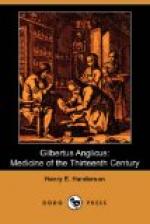Gilbert classifies variolae et morbilli among the universal and infectious diseases, and in the species apostemata. To this latter species belong also ignis Persicus, carbunculus and antrax.
[Footnote 9: It is at least interesting to know that small-pox is said to have made its first appearance in England in 1241.]
Variolae et morbilli arise from moist matter confined in the body and turbid, like turbid blood. Hence the disease occurs most commonly in boys and in those who are careless about cleanliness and neglect venesection. It is the result of a disposition of the blood resembling putrescence, in which there occurs an external ebullition in the efforts of nature to purify the interior of the body and to expel to the surface the virulent material within. Accordingly the common people declare that persons who have suffered from variolae et morbilli never acquire leprosy. Occasionally, too, the disease arises from excessive corruption of matter in repletion of blood, and hence it is more frequent in sanguineous diseases, like synocha, and during the prevalence of south winds or the shifting of winds to the south, and in infancy—the age characterized particularly by heat and moisture.
The eruptions vary in color in accordance with the mixture of the different humors with the corrupt blood. Hence some are light colored, some the color of saffron, some red, some green, some livid, some black, and the virulence of the disease is the greater, the nearer the color approaches to black. There are, too, four varieties of the eruption, distinguished by special names. When the eruption is light colored and tends to suppuration, it is called scora. When it is very fine and red, it is called morbilli or veterana. The distinction between variolae and morbilli is in the form and matter of the disease, for in variolae the pustules are large and the matter bilious (colerica), while in morbilli the eruption is smaller and does not penetrate the skin (non-pertransit cutem). Variolae, on the contrary, forms a prominent pustule (facit eminentiam). A third form of the disease displays only four or five large, black pustules on the whole body, and this form is the most dangerous, since it is due to an unnatural black bile, or to acute fevers, in which the humors are consumed. This variety bears the name of pustula. A fourth form is called lenticula. This latter form occurs sometimes with fever, like synocha, sometimes without fever, and it arises from pestilential air or corrupt food, or from sitting near a patient suffering from the disease, the exhalations of which are infectious.
The premonitory symptoms of variolae are a high fever, redness of the eyes, pain in the throat and chest, cough, itching of the nose, sneezing and pricking sensations over the surface of the body.




